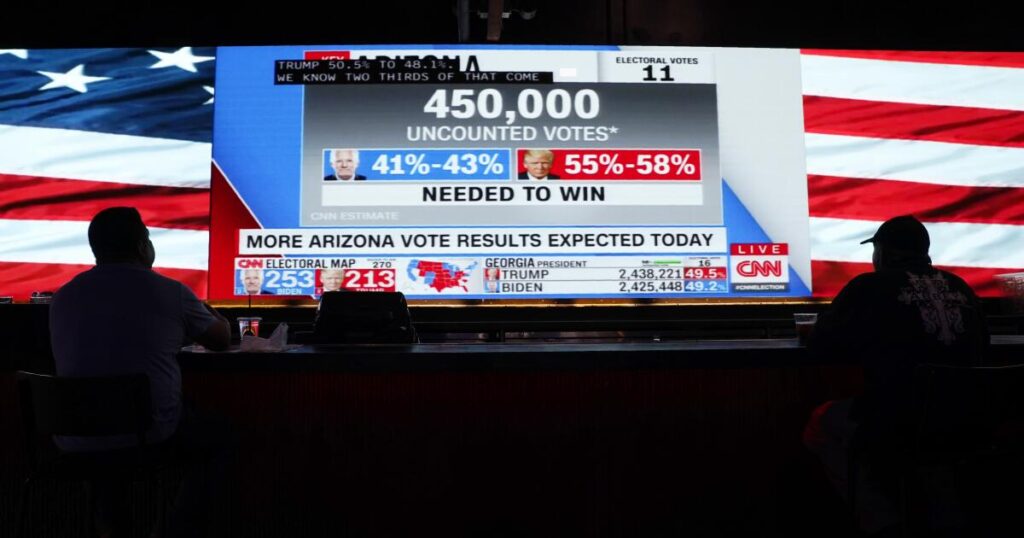[ad_1]
Ah, autumn: the season of pumpkin-spice everything, falling leaves and poll derangement syndrome.
These days, I wake up, log in and immediately look at the “Latest Polls” pages on Real Clear Politics and 538. My anxiety level on any given morning depends on the distance between the blue and red lines. Invariably, they are maddeningly close.
I know obsessing about polls is dumb, but how else can we decide what to stock up on before election day: champagne or antidepressants?
You’d think I would have learned my lesson eight years ago. Just before the 2016 election, my friend Suzanne was fretting that Donald Trump was going to beat Hillary Clinton. Suzanne is a sought-after hairstylist in Orange County, and she had been listening very closely to her clients, many of whom are politically conservative.
“Don’t be silly,” I told her as she blew my hair dry. “The polls all show Hillary winning decisively.”
I was so certain that I wrote in the memo section of the check I gave Suzanne, “Trump can’t win.”
I don’t make political predictions anymore.
The disparity between the 2016 polls and the election outcome was a “jarring event” for pollsters, as the American Assn. for Public Opinion Research put it in a postmortem. How could they have been so wrong?
It turns out that when the pollsters weighted their polls in an effort to correct discrepancies between their samples and the population, they failed to account for education levels. Their samples were skewed by the inclusion of too many college graduates, who tended to favor Clinton.
It was not entirely the pollsters’ fault, though. Until that election, there had never been such a stark divide between white voters who were college-educated and those who weren’t.
“It was a shock,” said Scott Keeter, an expert on American public opinion and political behavior at the Pew Research Center in Washington. “At least from the time of the New Deal, the non-college group actually tended to be more Democratic.”
In recent years, however, the appeal of populist politicians on the right and left has risen across the Western world, not just in the United States, undermining faith in government and institutions.
“Working-class and less-educated voters,” Keeter told me, “have become more supportive of the populist candidates.” Political scientists were aware of these trends, he said, “but Trump’s candidacy really crystallized the phenomenon.” Before 2016, education levels were simply not correlated with political views.
Curiously, the pollsters didn’t fare much better in the 2020 presidential election. Although they correctly predicted Biden’s victory, they dramatically overestimated his support. That was partly a result of record turnout: About a quarter of 2020 voters had not voted in 2016. But pollsters were also wrong about which candidate those new voters would choose. Preelection polling indicated that the new voters would be younger and tend to vote Democratic, but they were about evenly split between Biden and Trump.
The Harvard Gazette recently spoke to Biden’s chief 2020 pollster, John Anzalone, about why the polls have had such a mixed track record lately. For some reason, the polls have been less accurate when Trump was on the ballot.
“I think the challenges have a lot to do with modeling who’s going to turn out,” Anzalone said. “That has been an absolute mystery in the Trump era. I couldn’t tell you who’s going to turn out now.”
Years ago, the writer Arianna Huffington and the comedian Harry Shearer launched the tongue-in-cheek initiative the Partnership for a Poll-Free America. Their manifesto urged people to “hang up on the pollsters who are polluting our political environment by dominating media coverage, influencing election outcomes, and turning our political leaders into slavish poll followers.” It was a playful attempt to undermine the much-derided horse-race style of political journalism: Who’s up today? Who’s down?
But political coverage has evolved. Poll stories no longer dominate daily coverage.
Many research and news organizations that sponsor polls, Keeter said, “have stepped away from chasing the horse race and instead have focused more on trying to understand the dynamics, who the coalitions were and so forth. But the fact remains that people want to know who is ahead and who is behind.”
I know I do, and polls — however flawed — seem to be the only way to guess.
“If you didn’t have polls and were at the mercy of so-called man-on-the-street interviews or who is buying whose baseball caps, I think your anxiety levels would still be the same,” Keeter said. “There’s no cure for that.”
Threads: @rabcarian
[ad_2]
Source link
